 W
WThis is a list of people associated with the Salem Witch Trials, a series of hearings and prosecutions of people accused of witchcraft in colonial Massachusetts between March 1692 and May 1693. The trials resulted in the executions of twenty people, most of whom were women.
 W
WCapt. John Alden Jr. was a 17th-century American soldier, politician, merchant, and sailor. He was a well-known public figure in his time but is now chiefly remembered as a survivor of the Salem witch trials, of which he wrote a much quoted and studied account.
 W
WSarah Bibber was involved in the infamous Salem witch trials in 1692, both as an accuser of witchcraft, as well as being accused of being a witch herself.
 W
WBridget Bishop was the first person executed for witchcraft during the Salem witch trials in 1692. Nineteen were hanged, and one, Giles Corey was pressed to death. Altogether, about 200 people were tried.
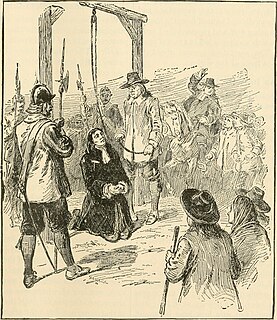 W
WGeorge Burroughs, was the only minister executed for witchcraft during the course of the Salem witch trials. He is best known for reciting the Lord's Prayer during his execution, something it was believed a witch could never do.
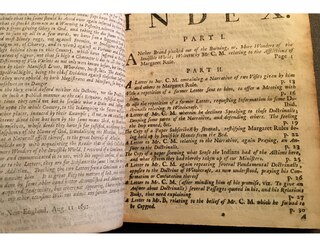 W
WRobert Calef was a cloth merchant in colonial Boston. He was the author of More Wonders of the Invisible World, a book composed throughout the mid-1690s denouncing the recent Salem witch trials of 1692–1693 and particularly examining the influential role played by Cotton Mather.
 W
WMartha Carrier was a Puritan accused and convicted of being a witch during the 1692 Salem witch trials.
 W
WRichard Carrier was a witness during the 1692 Salem witch trials who needed to testify against his mother.
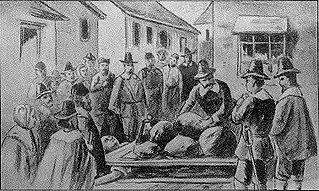 W
WGiles Corey was an English-born American farmer who was accused of witchcraft along with his wife Martha Corey during the Salem witch trials. After being arrested, Corey refused to enter a plea of guilty or not guilty. He was subjected to pressing in an effort to force him to plead—the only example of such a sanction in American history—and died after three days of this torture.
 W
WMartha Corey was accused and convicted of witchcraft during the Salem witch trials, on September 9, 1692, and was hanged on September 22, 1692. Her second husband, Giles Corey, was also accused.
 W
WElizabeth Booth was born in 1674 and was one of the accusers in the Salem Witch Trials. She grew up in Salem, Massachusetts, as the second eldest of ten children. When she was sixteen she was accused of being a witch. When she was eighteen, she began accusing people of practicing witchcraft, including John Proctor, Elizabeth Proctor, Sarah Proctor, William Proctor, Benjamin Proctor, Woody Proctor, Giles Corey, Martha Corey, Job Tookey, and Wilmont Redd. Five of these people were executed due to Booth's testimony. Elizabeth Proctor would have been executed as well if she was not pregnant. After the Witch Trials, Booth married Israel Shaw on December 26, 1695, and had two children named Israel and Susanna. Booth's death date is unknown.
 W
WSarah Good was one of the first three women to be accused of witchcraft in the Salem witch trials, which occurred in 1692 in colonial Massachusetts.
 W
WSarah Good was one of the first three women to be accused of witchcraft in the Salem witch trials, which occurred in 1692 in colonial Massachusetts.
 W
WJohn Hale, was the Puritan pastor of Beverly, Massachusetts, during the Salem witch trials in 1692. He was one of the most prominent and influential ministers associated with the witch trials, being noted as having initially supported the trials and then changing his mind and publishing a critique of them.
 W
WMercy Lewis was an accuser during the Salem Witch Trials. She was born in Falmouth, Maine. Mercy Lewis, formally known as Mercy Allen, was the child of Philip Lewis and Mary (Cass) Lewis.
 W
WCotton Mather was a New England Puritan minister, prolific author, and pamphleteer. One of the most important intellectual figures in English-speaking colonial America, Mather is remembered today chiefly for his Magnalia Christi Americana (1702) and other works of history, for his scientific contributions to plant hybridization and to the promotion of inoculation as a means of preventing smallpox and other infectious diseases, and for his involvement in the events surrounding the Salem witch trials of 1692–3. He also promoted the new Newtonian science in America and sent many scientific reports to the Royal Society of London, which formally elected him as a fellow in 1723. A controversial figure in his own day, he sought unsuccessfully the presidency of Harvard College, which had been held by his father Increase, another important Puritan intellectual.
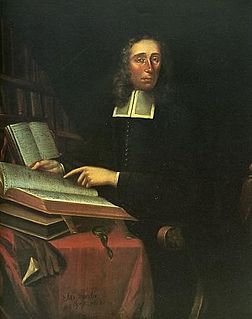 W
WIncrease Mather was an American Puritan clergyman in the Massachusetts Bay Colony and president of Harvard College for twenty years (1681–1701). He was influential in the administration of the colony during a time that coincided with the notorious Salem witch trials.
 W
WRebecca Nurse was accused of witchcraft and executed in New England during the Salem Witch Trials of 1692. She was fully exonerated less than twenty years later.
 W
WSamuel Parris was the Puritan minister in Salem Village, Massachusetts, during the Salem witch trials. He was also the father of one of the afflicted girls, and the uncle of another.
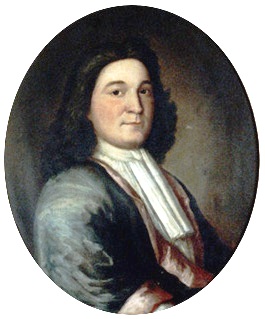 W
WSir William Phips was born in Maine in the Massachusetts Bay Colony and was of humble origin, uneducated, and fatherless from a young age but rapidly advanced from shepherd boy, to shipwright, ship's captain and treasure hunter, the first New England native to be knighted, and the first royally appointed governor of the Province of Massachusetts Bay. Phips was famous in his lifetime for recovering a large treasure from a sunken Spanish galleon, but is perhaps best remembered today for establishing the court associated with the infamous Salem Witch Trials, which he grew unhappy with, and forced to prematurely disband after five months.
 W
WRobert Pike (1616—1706) was an opponent of the Salem witchcraft prosecutions of 1692. He was also involved in two other notable, public controversies prior to 1692. The first was his open criticism of the persecution of the Quakers, for which he was arraigned by the Massachusetts General Court in 1653. Years later, he became embroiled in a long feud with the pastor of Salisbury, the Reverend John Wheelwright, who excommunicated him in 1675 and was later obliged to reinstate him.
 W
WAnn Pudeator was a well-to-do septuagenarian widow who was accused of and convicted of witchcraft in the Salem witch trials in colonial Massachusetts. She was executed by hanging.
 W
WAnn Putnam , along with Elizabeth Hubbard, Mary Walcott, Mercy Lewis, Abigail Williams and Mary Warren |Abigail Williams]], was an important witness at the Salem Witch Trials of Massachusetts during the later portion of 17th-century Colonial America. Born 1679 in Salem Village, Essex County, Massachusetts Bay Colony, she was the eldest child of Thomas (1652–1699) and Ann Putnam (1661–1699).
 W
WWilmot Redd was one of the victims of the Salem witch trials of 1692. She was born in Marblehead, Massachusetts, and executed by hanging on September 22, 1692. Her husband was Samuel Redd, a fisherman. She was known for her irritability, but she was given little serious attention and, to her neighbors, was "probably more bitch than witch."
 W
WMargaret Scott was found guilty of witchcraft during the Salem witch trials and was executed by hanging on September 22, 1692. She was part of the last group to be executed, which also included Mary Eastey, Martha Corey, Ann Pudeator, Samuel Wardwell, Mary Parker, Alice Parker, and Wilmot Redd. She was the only accused person from Rowley to be executed. As a lower-class, long-term widow, having lost several children in infancy, she was a prototypical witch candidate. When her husband, Benjamin, died, he left a very small estate and she, being unable to remarry, was reduced to begging, which invited resentment and suspicion. In this manner, her circumstances were comparable to fellow victim Sarah Good.
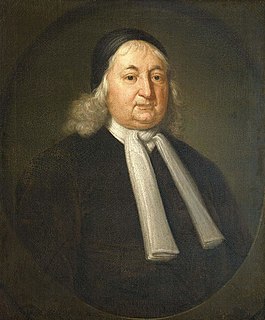 W
WSamuel Sewall was a judge, businessman, and printer in the Province of Massachusetts Bay, best known for his involvement in the Salem witch trials, for which he later apologized, and his essay The Selling of Joseph (1700), which criticized slavery. He served for many years as the chief justice of the Massachusetts Superior Court of Judicature, the province's high court.
 W
WWilliam Stoughton was a colonial magistrate and administrator in the Province of Massachusetts Bay. He was in charge of what have come to be known as the Salem Witch Trials, first as the Chief Justice of the Special Court of Oyer and Terminer in 1692, and then as the Chief Justice of the Superior Court of Judicature in 1693. In these trials he controversially accepted spectral evidence. Unlike some of the other magistrates, he never admitted to the possibility that his acceptance of such evidence was in error.
 W
WTituba was the first woman to be accused of practicing witchcraft during the 1693 Salem witch trials. She was enslaved and owned by Samuel Parris of Danvers, Massachusetts. Although her origins are debated, research has suggested that she was a South American native and sailed from Barbados to New England with Samuel Parris. Little is known regarding Tituba's life prior to her enslavement. She became a pivotal figure in the witch trials when she confessed to witchcraft while also making claims that both Sarah Good and Sarah Osborne participated in said witchcraft. She was imprisoned and later released by Samuel Conklin, but little to nothing is known about Tituba's life following her subsequent release.
 W
WPeter Tufts was a prominent early citizen of Medford, Massachusetts, and ancestor of Charles Tufts who donated land for the Tufts University campus. The Peter Tufts House is still standing; it is believed by some historians to be the oldest all-brick house in the United States.
 W
WSamuel Wardwell was a man accused of witchcraft during the Salem witch trials of 1692. He was executed by hanging on September 22, 1692, along with Alice Parker, Martha Corey, Mary Eastey, Ann Pudeator, Mary Parker, Wilmot Redd, and Margaret Scott.
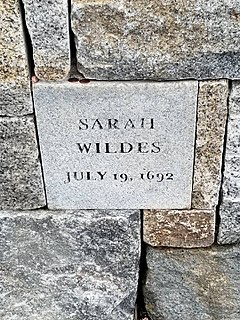 W
WSarah Wildes was wrongly convicted of witchcraft during the Salem witch trials and was executed by hanging. She maintained her innocence throughout the process, and was later exonerated. Her husband's first wife was a member of the Gould family, cousins of the Putnam family, the primary accusers, and court records document the family feuds which led to her persecution.
 W
WJohn Willard was one of the people executed for witchcraft in Salem, Massachusetts, during the Salem witch trials of 1692. He was hanged on Gallows Hill, Salem on August 19, 1692.
 W
WReverend Samuel Willard was a colonial clergyman. He was born in Concord, Massachusetts, graduated Harvard in 1659, and was minister at Groton from 1663–1676, whence he was driven by the Indians during King Philip's War. Willard was pastor of the Third Church, Boston from 1678 until his death. He opposed the Salem witch trials, and served as acting president of Harvard from 1701. He published many sermons; the folio volume A Compleat Body of Divinity was published posthumously in 1726.
 W
WMary Walcott was one of the "afflicted" girls called as a witness at the Salem witch trials in early 1692-93.